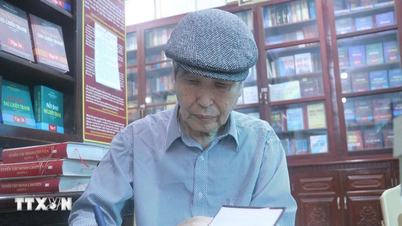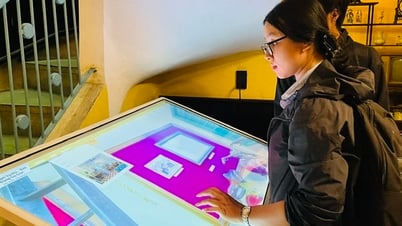“I'm going.” - “Okay, I'll walk you to the door. Don't forget your phone and keys!”
The conversation seemed to be between two family members, but was actually a message from Xiao Li - a robot that supports the elderly - to Ms. Liu Xian, a retired teacher in Beijing (China).
First meeting at the 2024 World Robot Conference, Xiao Li has gradually become an indispensable part of Liu Xian's daily life.
This robot reminds her to take her medicine on time, finds lost items, chats with her every day, and helps her when something goes wrong. Thanks to Xiao Li, she no longer feels lonely during long days at home alone.
In the context of China's rapidly aging population - where by the end of 2024 there will be more than 200 million people over 65 years old, or 1 in 7 people - caring for the elderly is a major challenge.
In fact, robots have gradually “infiltrated” many aspects of elderly care in this country of a billion people. In nursing homes, robots help support patients, monitor their health, and even assist with bathing.
Currently, most of the units using robots are medical facilities, while applications in households are still quite limited, due to barriers such as incomplete technology, high cost or lack of accompanying support services.
At a nursing home in Guangdong, the elderly can play chess with robots or receive heat therapy.
However, many devices still require human help to start them up, and robots sometimes freeze in the face of complex sentences or noisy environments.
Price is also a big issue. A robot capable of online chat and medical support can cost as much as 140,000 yuan ($19,400), while walking robots range from 10,000 to 30,000 yuan ($1,300 to $4,000), and advanced rehabilitation equipment often exceeds 100,000 yuan ($13,600).
However, industry experts remain optimistic about the application of modern technology in elderly care.
Liu Qingfeng, Chairman of China's leading technology and artificial intelligence (AI) group iFLYTEK, predicts that companion robots could become common in households within the next three years, while more advanced models to assist people with limited mobility could become more common within five years.
These prospects have received support from national policy.
At the end of 2024, the Chinese government gave the green light and issued guidelines to promote the application of elderly care technology to solve the problem of population aging.
However, experts also emphasize that robots can support, but cannot replace the care and affection from relatives. No matter how modern technology is, the warmth of family is still the most precious thing for the elderly./.
Source: https://www.vietnamplus.vn/trung-quoc-khi-robot-tro-thanh-nguoi-ban-dong-hanh-voi-nguoi-cao-tuoi-post1033405.vnp



![[Photo] Prime Minister Pham Minh Chinh holds talks with Prime Minister of the Kingdom of Thailand Paetongtarn Shinawatra](https://vphoto.vietnam.vn/thumb/1200x675/vietnam/resource/IMAGE/2025/5/16/23b5dd1e595d429491a54e3c1548fb79)
![[Photo] Welcoming ceremony for Prime Minister of the Kingdom of Thailand Paetongtarn Shinawatra on official visit to Vietnam](https://vphoto.vietnam.vn/thumb/1200x675/vietnam/resource/IMAGE/2025/5/16/cdd9e93739c54bb2858d76c3b203b437)





















































































Comment (0)